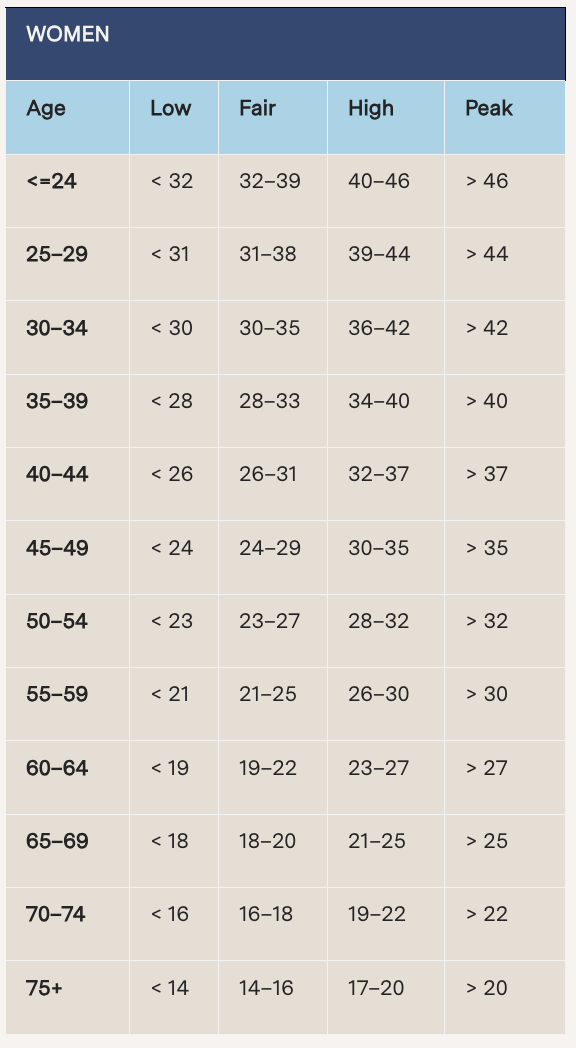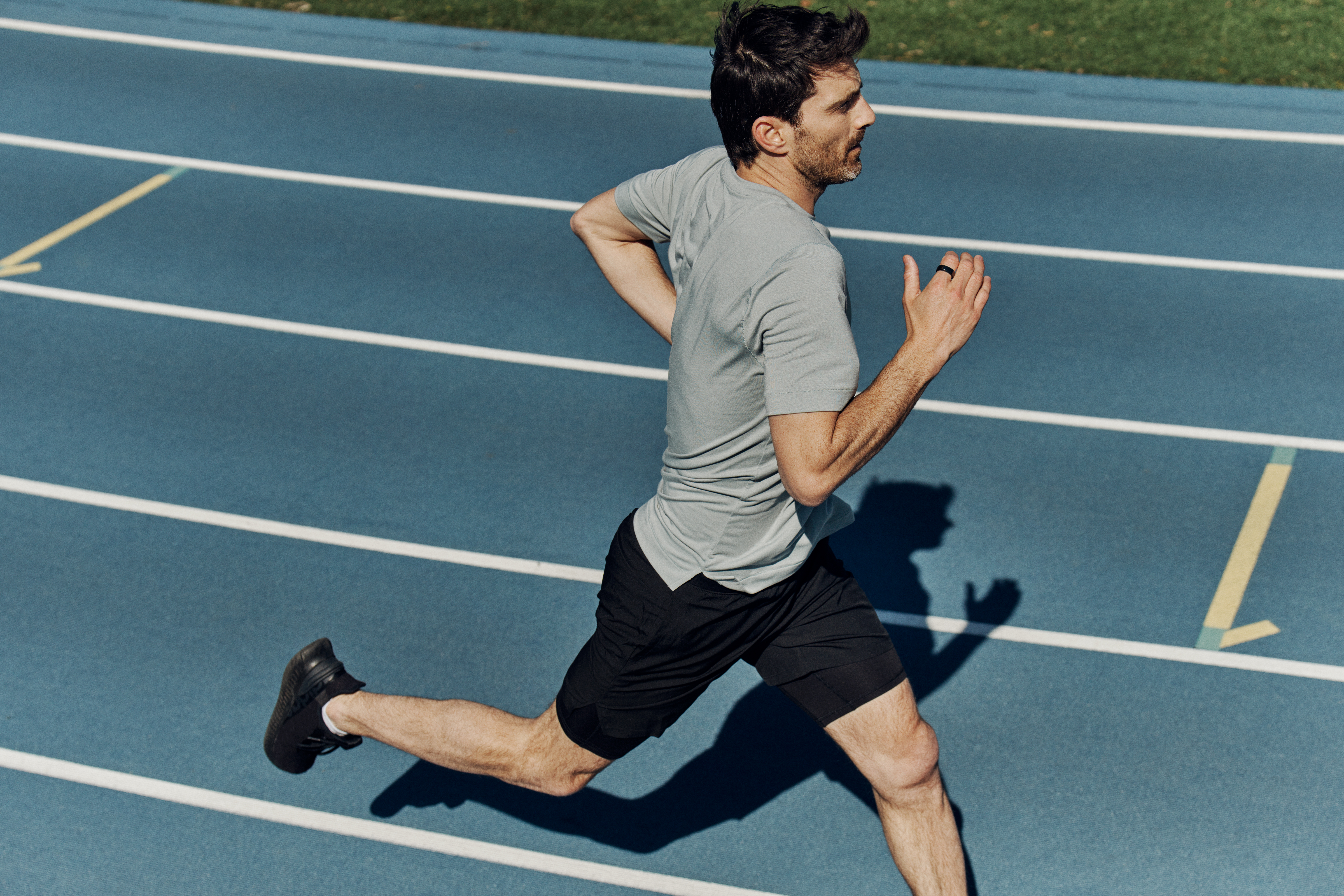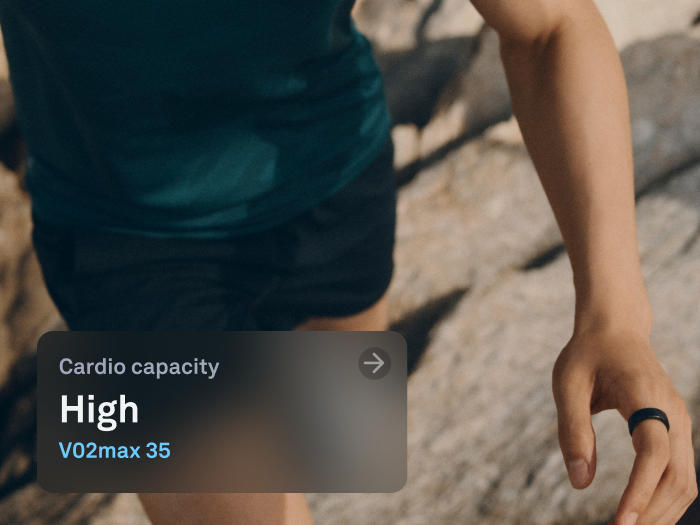Imagine walking briskly up a steep flight of stairs. Is it a breeze, or does it leave you out of breath? This is a clue into your cardio capacity.
As part of Oura’s new Heart Health features, Cardio Capacity provides an estimate of your VO2 max, or how efficiently your body delivers and utilizes oxygen during intense physical effort.
Along with Cardiovascular Age and other Oura data and insights, this new feature provides a window into the status of your entire cardiovascular system and holistic, long-term health.
| Member Tip: Initially, your Cardio Capacity estimate is based on characteristics that you entered in My profile in the Oura App. This number is an estimate only, based on population averages. Complete the walking test for a more accurate assessment. |
LEARN MORE: Cardio Capacity Support Center
What Is Cardio Capacity (VO2 Max)?
When you engage in intense physical activity (think: running), a series of physiological responses occur. First, your heart rate increases, which pumps more blood to your muscles, delivering oxygen and nutrients necessary for energy production. Your blood vessels dilate to enhance blood flow, while your heart’s left ventricle stretches larger to allow each beat to deliver a bigger bolus of blood.
As your muscles start to work harder, you also start breathing harder to intake more oxygen and eliminate carbon dioxide. Oxygen passes through the lungs to the blood, binding to hemoglobin and reaching the working muscles, where it is used to make adenosine triphosphate (ATP) — energy (or fuel) for your muscles.
Your cardio capacity (VO2 max) is determined by how efficiently your body performs this coordinated effort between the heart, blood, vasculature, muscles, and lungs.
The greater your VO2 max, the greater your body’s ability to supply oxygen to your muscles during physical activity. “Conversely, with a lower VO2 max, your heart rate has to increase to move the oxygen through various organ systems,” explains Pauli Ohukainen, PhD, Senior Research Scientist at Oura.
How Is VO2 Max Measured?
There are two main tests typically used to measure a person’s VO2 max.
The Maximal Exercise Test, the Gold Standard

The maximal exercise test is considered the most accurate testing method as it directly measures the amount of oxygen the body is able to use during intense effort.
However, due to the equipment and personnel involved, this type of testing tends to be costly and time-intensive. It’s also not suitable for all populations, such as older adults or those with preexisting health conditions, as it requires an intense physical effort.
In the test, a person (usually exercising on a treadmill or cycle ergometer) wears a mask or mouthpiece connected to a metabolic cart, which measures the amount of oxygen consumed and carbon dioxide produced during breathing. The test begins at a relatively easy level, and then the exercise intensity level increases until the subject is pushed to their maximal effort.
VO2 max is then calculated based on the highest rate of oxygen consumption measured during the test. The result is usually given in milliliters of oxygen used per minute per kilogram of body weight (ml/kg/min).
The Submaximal VO2 Max Test
A less costly and more accessible VO2 max test is a submaximal test. Oura employs this method to estimate VO2 max.
A submaximal test involves a person exercising at a lower intensity level, such as walking briskly. In submaximal tests, a person’s heart rate responses to graded exercise sessions are compared to standard tables or equations to estimate the maximum oxygen uptake.
A relatively low resting heart rate that quickly returns to baseline after exertion signifies a higher VO2 max, while a relatively high resting heart rate that stays elevated after exertion signifies a lower VO2 max.
“This test is easier to interpret, doesn’t have the same practical limitations as formal VO2 max testing, and doesn’t carry the same risks,” notes Marco Altini, PhD, an Oura data science advisor and movement expert.
How Oura Estimates Your VO2 Max

As with Cardiovascular Age, Oura provides an estimate of your VO2 max based on research-backed methods. Though not as accurate as the lab-based maximal test, Oura’s VO2 max feature provides a broad estimate of your current cardiorespiratory health. You can utilize this information to inform your current cardiorespiratory fitness and track how it changes over time.
In the Oura App, the initial reading will show a number based on anthropometric data (age, sex, height, and weight) as entered in My profile. This number is an estimate only, based on population averages.
For a more precise estimate of your Cardio Capacity, Oura will prompt you to complete a six-minute walking test. Alternatively, you can manually add a VO2 max value if you have a lab test result or a VO2 max reading from a trusted source.
Depending on your VO2 max estimate, Oura will categorize your Cardio Capacity into one of four levels:
- Peak: very high within your age group
- High: high within your age group
- Fair: average or slightly below average within your age group
- Low: below average within your age group
Oura’s VO2 max classifications are based on the research-backed reference values for women and men, shown in the charts below.


Why Cardio Capacity Matters
“Cardiorespiratory fitness is one of the most important determinants of health and well-being,” says Altini. “While step count and energy expenditure are important, they mainly reflect behavior rather than health status.”
There’s a reason why athletes closely monitor their VO2 max: “It can provide a proxy for performance and fitness and help you understand if you are getting in better shape,” says Altini.
But cardio capacity is not just about athletic ability — it also reflects the efficiency and health of your heart. Oxygen delivery is essential for numerous physiological processes, including energy production, brain function, and muscle function. All in all, the more efficiently you can consume and use oxygen, the better.
Research shows that cardio capacity is associated with other significant health outcomes, including longevity, sleep quality, and risk of disease. Cardiorespiratory fitness, as measured by VO2 max, has also been shown to be a key predictor of health and longevity.
A low VO2 max is associated with a greater risk of future cardiovascular disease, reduced mental health, lower sleep quality, and an increased risk of all-cause mortality. Fortunately, there are well-established strategies to increase your cardio capacity.
How to Increase Your Cardio Capacity

“Nothing benefits the cardiovascular system more than aerobic exercise,” Ohukainen says. “It helps us build a strong heart and flexible arteries and ensures their ability to respond to changing demands.”
Cardio capacity, in particular, responds well to training and lifestyle modifications, no matter your age. For instance, a study found that men and women in their 60s were able to increase their VO2 max after 9 months of endurance training.
To improve your own cardio capacity, consider integrating these training tips into your exercise routine.
1. Incorporate high-intensity interval training (HIIT).
You’ll want to perform this at or near your maximum heart rate, which, roughly speaking, is 220 minus your age. “To increase your VO2 max, aim to incorporate one HIIT session per week that elevates your heart rate close to this figure,” says Altini.
Note that exercising at this heart rate may feel hard, as it should be! As a result, you may only be able to sustain this high level of exertion for a few minutes. That’s perfectly fine—a little goes a long way.
READ MORE: Defining Low, Medium, and High-Intensity Movement & Using Oura to Track It
2. Schedule more low-intensity endurance exercise sessions.
Low-intensity training is performed at about 60-70% of your max heart rate — think of exercise like a long walk, a leisurely bike ride, or a jog. Research has shown this can increase VO2 max, as it trains your heart and lungs to sustain activity at moderate intensities.
READ MORE: How Oura Measures Steps & Activity
3. Stay the course.
Whether you’re new to exercise or you’ve been training for years, staying consistent with exercise is vital to improving cardio capacity. When you exercise regularly, your muscles get better at using oxygen, which helps them work more efficiently.
Plus, the more you exercise, the more mitochondria your muscles make — and mitochondria produce ATP, contributing to oxygen consumption and exercise capacity.
RELATED: 7 Benefits of Regular Physical Activity & Easy Ways to Get More
ŌURA products and services are not medical devices, and are not intended to mitigate, prevent, treat, cure or diagnose any disease or condition. If you have any concerns about your health, please consult your doctor.
About the Oura Experts
Pauli Ohukainen, PhD, is a Senior Research Scientist at Oura’s Future Physiology Team, where he is responsible for designing and leading clinical cardiometabolic research projects. Ohukainen has an M.Sc in biochemistry and molecular biology. He did his PhD in the department of Pharmacology and Toxicology, University of Oulu, Finland, on the molecular mechanisms of human aortic valve calcification. He has published more than 20 peer-reviewed articles, and has been a PhD supervisor and a lecturer for medical students.
Marco Altini, PhD, is an Oura advisor and has a PhD cum laude in applied machine learning, a M.Sc. cum laude in computer science engineering, and a M.Sc. cum laude in human movement sciences and high-performance coaching. He has published more than 50 papers and patents at the intersection between physiology, health, technology, and human performance.










